| Weight | 185 g |
|---|---|
| Dimensions | 60 mm |
| Focal Length (mm) | |
| Max Aperture (f) | |
| Min Aperture (f) | |
| Aperture Blades | |
| Elements | |
| Sharp (Near) | |
| Sharp (Far) | |
| Rear Mount | |
| Flange-Focal Distance (mm @ ∞) | |
| RF/L Extension (mm) |
Schneider Procolar 60/2.2
£59.00
Slide projector lens for Kodak Carousel. Black plastic barrel. Aperture unmarked. Samples available for sale converted to M42.
Category: Transparencies
Reviews
Add a review Cancel reply
Related to . . .
Related products
-

Bell & Howell Trionar 127/4
Compare -

Agfa Agolar 85/2.5
Compare -

Pentacon AV 200/4
Compare -

Agfa Agomar 100/2.5 [V2]
Compare -

Apollo 90/2.8
Compare -

Aldis Anastigmat 85/2.5 [V1]
Compare -

Agfa Agomar 85/2.5 [V1]
Compare -

Agfa Agomar 90/2.4
Compare -

AG Optical Trionar 152/3.5
Compare -

Argus Projection 100/2.8
Compare -

Pentacon AV 150/2.8
Compare -
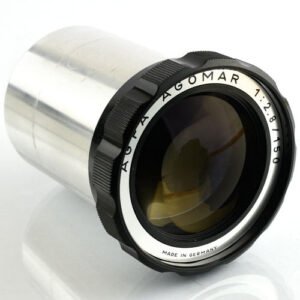
Agfa Agomar 150/2.8 [V2]
Compare -
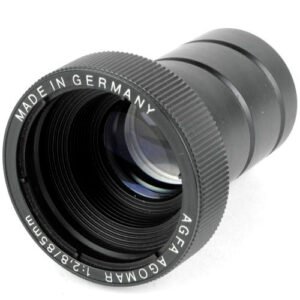
Agfa Agomar 85/2.8 [V4]
Compare -

Agfa Color-Agolar 250/4.5
Compare -

Arsenal Triar-1 150/3.5
Compare -

Apollo 85-150/3.5
Compare -

Agfa Agomar 85-150/4
Compare -

Benoist Berthiot 110/2.4
Compare -

Ansco 127/3.5
Compare -

Bell & Howell Trionar 100/3.5
Compare -
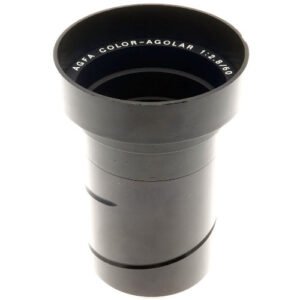
Agfa Color-Agolar 60/2.8
Compare -
 SOFT
SOFTAgfa Agomar 90/2.8
CompareSOFT -

Apollo 100-150/3.5
Compare -

Agfa Agomar 60/2.8
Compare -

Benoist Berthiot 90/2.5
Compare
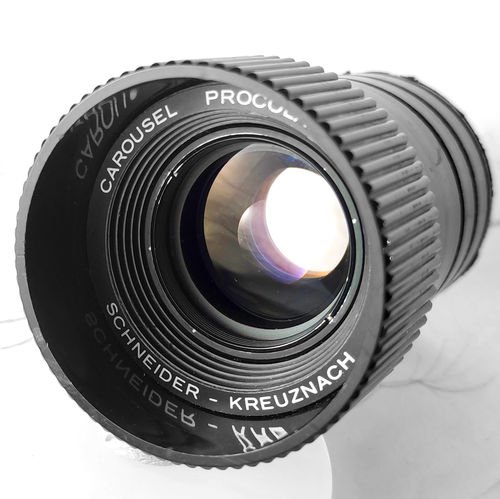







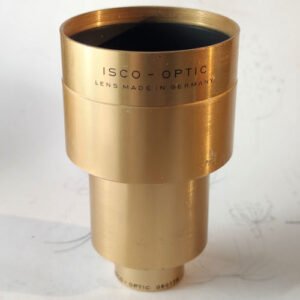

16:9 –
This is among the most attractive projector lenses to suffer the indignity of a plastic housing. Inside that 4mm-thick barrel is a proper (though unserialed) Schneider metal lens case, and inside that are four, not three elements. It’s heavier and better than it looks.
An optimistic manufacturer might have labeled this unmarked 60mm lens f2.0, though its maximum aperture seems to lie between f2.1-2.3, and it’s therefore appropriate to compare the Procolar 60 to its six-element sibling (cousin, once-removed?), the Isco Ultra-MC 60/2. Both lenses are a little better at middle distance than close-up. The Isco cine projector lens is mechanically much more impressive, and considerably sharper (8.3 v 7.6) in Zone 1. However, Zone 3 is conspicuously worse than the Procolar 60 – especially close-up, where the gap widens to 5.1 v 6.2. Neither lens has useably sharp corners, and it could be argued that for its intended use the Ultra-MC’s resolution fall-off is a bonus for isolation of a central subject, but the fact is that the Procolar is more consistent in its rendering: not varying as much across the frame, and not varying quite as much with distance as the tricky little Isco – and that’s just, barely enough to earn the Procolar the Bronze award denied to the Ultra-MC 60/2.
Bokeh, too is better behaved: the Procolar’s specular highlights remain round until the outer part of Zone 2, whereas the Isco goes cat-eye from the edge of Zone 1 – giving the impression of a larger image circle and less swirl. Both lenses have attractive rendition without onion ringing. The Procolar’s bubble game is quite subtle: in strong light it can be excited (much more than the Isco) but in moderate conditions its highlights are rather self-effacing. However, the Ultra-MCs more vivid colours, better contrast and greater resistance to flare are unmistakable hallmarks of its pedigree.
Nonetheless, the Procolar is a lens worth adapting: all the air-spaced elements are accessible for cleaning and renovation via standard lens rings. Several clamp-ring adaptors are available that will fit its big Kodak-spiral 56mm barrel, but beware its unusually long focal-flange distance. A viable DIY option is to dremel away a carefully-leveled section of the outer plastic barrel and cement on a bored out M42 body cap. On our test sample, a threaded body cap was installed 35mm behind the hood. However, even with 11mm of rear-element housing protruding beyond the new lens flange, a helical extension of 52mm is needed to acquire infinity focus – giving a F-FD of 72mm.